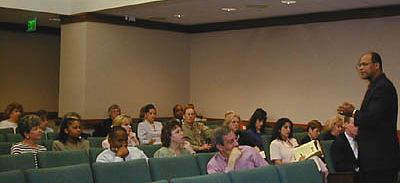| Human Resource Management Task Force
Austin, May 24, 2000
Comptroller's Office Hears Human Resources Concerns in Austin
 State agencies need to adopt a marketing mind-set to successfully recruit and retain top flight employees, according to testimony at the May 24 e-Texas Human Resource Management Task Force hearing in Austin.
State agencies need to adopt a marketing mind-set to successfully recruit and retain top flight employees, according to testimony at the May 24 e-Texas Human Resource Management Task Force hearing in Austin.
More-->
|
Laura Ayoub Keith, Task Force Commissioner
The long-term success of any organization depends on its employees, making human resource management an important factor for every state agency. Approximately 212 agencies and institutions of higher education report quarterly on full-time equivalent employees (FTEs). The State of Texas employs nearly 250,000 full-time state workers and about 70,000 part-time employees. Fifty-six percent of those employees work in state agencies, while 44 percent work at institutions of higher education.
There was an 8 percent increase in FTEs in the past five years due to a nearly 50 percent increase at public safety and criminal justice agencies, an 11.1 percent increase at institutions of higher education, and a 12.5 percent decrease at health and human service agencies. The state's turnover rate for fiscal year 1998 was over 17 percent for full-time classified employees.
Salaries and benefits for all state employees are a large share of the state budget. The expenditures for state employees include salaries, insurance premiums, sick leave, vacation, retirement contributions, and longevity payments. During fiscal 1999 those costs were about $9.7 billion or 21.3 percent of total expenditures for the state.
Texas has a decentralized approach to managing its human resources. Each agency is responsible for its own policies and procedures for hiring, training, and retention efforts. Employment procedures differ from agency to agency and are greatly influenced by the number of employees in the agency—over 70 Texas state agencies have 100 or fewer employees.
The Human Resource Management Team will research all aspects of state employment, cull best practices from private companies and develop new ideas to improve employee morale and productivity. The team's integrated approach will be to address issues relating to total workforce planning and management, addressing the major components of Human Resource Management (HRM), including recruitment, retention, performance evaluation and compensation, benefits, training, the maturing workforce, and the effects on agencies of current laws and regulations concerning HRM/administration. Because the State Classification Plan is the foundation upon which state employment is based, the team will assess how its structure and administration affect various areas of human resource management, including recruitment and retention, compensation, performance evaluations, career ladders and professional development.
The use of technology will also be a focus for this team in order to increase capabilities for service delivery, to improve the administration of human resource programs already in place, and to identify ways to use technology in new ways.
An overall goal for this team is to help Texas create a more flexible workforce designed to meet the challenges and changing needs of the 21st century.
|

